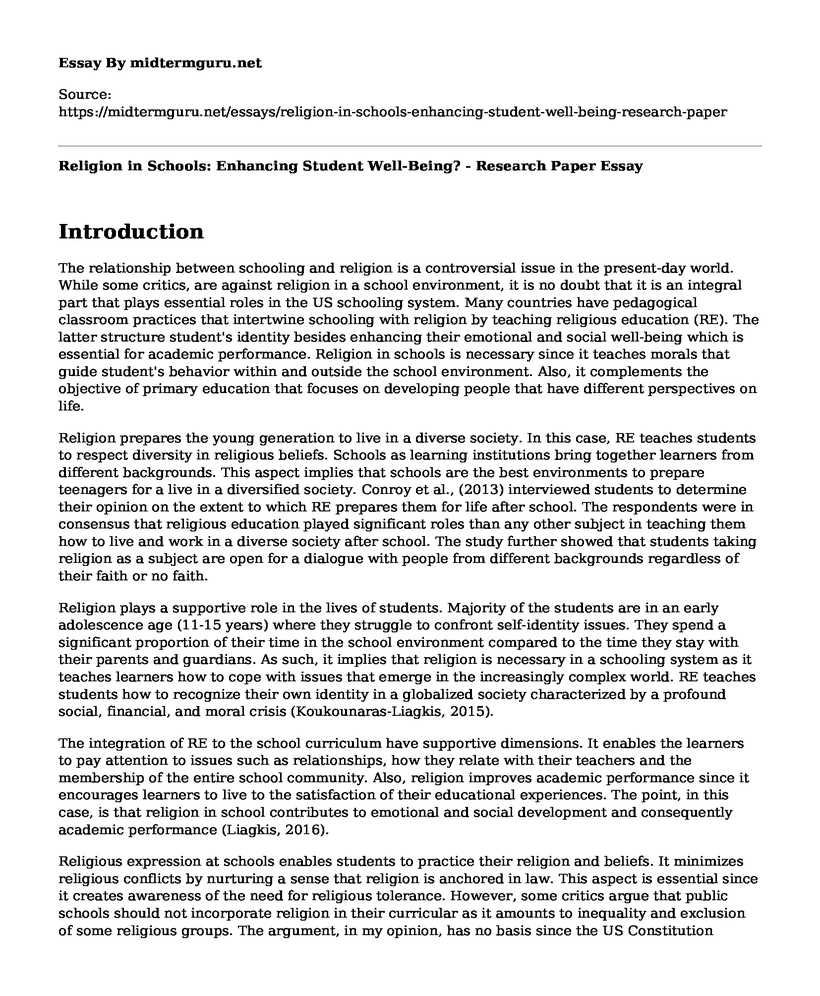Introduction
The relationship between schooling and religion is a controversial issue in the present-day world. While some critics, are against religion in a school environment, it is no doubt that it is an integral part that plays essential roles in the US schooling system. Many countries have pedagogical classroom practices that intertwine schooling with religion by teaching religious education (RE). The latter structure student's identity besides enhancing their emotional and social well-being which is essential for academic performance. Religion in schools is necessary since it teaches morals that guide student's behavior within and outside the school environment. Also, it complements the objective of primary education that focuses on developing people that have different perspectives on life.
Religion prepares the young generation to live in a diverse society. In this case, RE teaches students to respect diversity in religious beliefs. Schools as learning institutions bring together learners from different backgrounds. This aspect implies that schools are the best environments to prepare teenagers for a live in a diversified society. Conroy et al., (2013) interviewed students to determine their opinion on the extent to which RE prepares them for life after school. The respondents were in consensus that religious education played significant roles than any other subject in teaching them how to live and work in a diverse society after school. The study further showed that students taking religion as a subject are open for a dialogue with people from different backgrounds regardless of their faith or no faith.
Religion plays a supportive role in the lives of students. Majority of the students are in an early adolescence age (11-15 years) where they struggle to confront self-identity issues. They spend a significant proportion of their time in the school environment compared to the time they stay with their parents and guardians. As such, it implies that religion is necessary in a schooling system as it teaches learners how to cope with issues that emerge in the increasingly complex world. RE teaches students how to recognize their own identity in a globalized society characterized by a profound social, financial, and moral crisis (Koukounaras-Liagkis, 2015).
The integration of RE to the school curriculum have supportive dimensions. It enables the learners to pay attention to issues such as relationships, how they relate with their teachers and the membership of the entire school community. Also, religion improves academic performance since it encourages learners to live to the satisfaction of their educational experiences. The point, in this case, is that religion in school contributes to emotional and social development and consequently academic performance (Liagkis, 2016).
Religious expression at schools enables students to practice their religion and beliefs. It minimizes religious conflicts by nurturing a sense that religion is anchored in law. This aspect is essential since it creates awareness of the need for religious tolerance. However, some critics argue that public schools should not incorporate religion in their curricular as it amounts to inequality and exclusion of some religious groups. The argument, in my opinion, has no basis since the US Constitution require public schools to protect their pupils from harassment and discrimination based on religion. The First Amendment to the US Constitution acknowledges that students have a right to practice their religion and express their beliefs through school assignments and homework (OPSI, 2018). Conclusively, religion in schools plays critical roles that contribute to academic performance, emotional and social development. Also, it prepares students to embrace religious tolerance, cope with moral issues in a pluralistic world.
References
Conroy, J.C., Lundie, D., Davis, R.A., Baumfield, V., Barnes, L.P., Gallagher, T., Lowden, K., Bourque, N. & Wenell, K. Journal of Empirical Theology, 28(1), 136-137. DOI: 10.1163/15709256-12341311.
Koukounaras-Liagkis, M. (2015). Religion and Religious Diversity within Education in a Social Pedagogical Context in Times of Crisis: Can Religious Education Contribute to
Community Cohesion? International Journal of Social Pedagogy. DOI: 10.14324/111.444.ijsp.2015.v4.1.007.
Liagkis, M. K. (2016). Teaching Religious Education in Schools and Adolescents' Social and Emotional Development. An Action Research on the Role of Religious Education and School Community in Adolescents' Lives. Journal of Cultural and Religious Studies, 4(2). DOI:10.17265/2328-2177/2016.02.004.
OPSI- Office of Superintendent of Public Instruction. (2018.). Religion in Schools: State of Washington. Website. Retrieved April 16, from http://www.k12.wa.us/Equity/ReligionInSchools/default.aspx/url/
Cite this page
Religion in Schools: Enhancing Student Well-Being? - Research Paper. (2022, Dec 27). Retrieved from https://midtermguru.com/essays/religion-in-schools-enhancing-student-well-being-research-paper
If you are the original author of this essay and no longer wish to have it published on the midtermguru.com website, please click below to request its removal:
- Essay on Cause and Effect of How the Internet Influences Young Children
- Social Context of the Society That Affects Many Parts of the World
- Essay Sample on Early Recognition of Developmental Disabilities
- Essay Sample on Communication and Media
- Development: Freedom, Prosperity, Quality Services, Poverty Eradication - Essay Sample
- Social Construction of Race and Ethnicity - Essay Sample
- Friends: Our Essential Need for Companionship - Essay Sample







